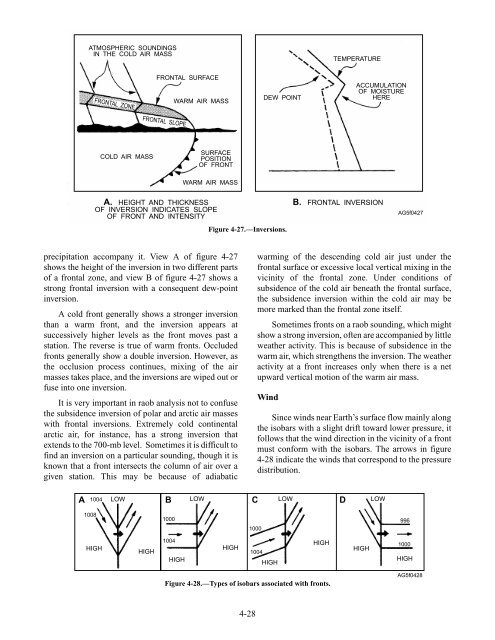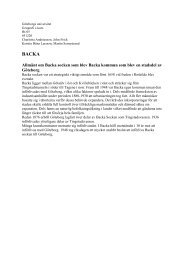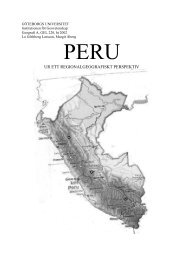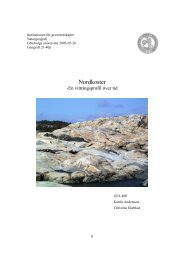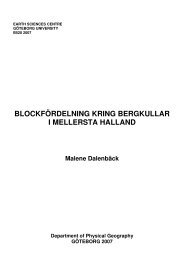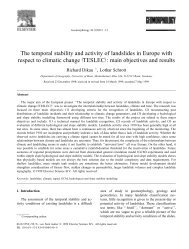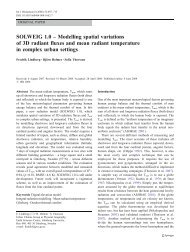AIR MASSES AND FRONTS
AIR MASSES AND FRONTS
AIR MASSES AND FRONTS
Create successful ePaper yourself
Turn your PDF publications into a flip-book with our unique Google optimized e-Paper software.
precipitation accompany it. View A of figure 4-27<br />
shows the height of the inversion in two different parts<br />
of a frontal zone, and view B of figure 4-27 shows a<br />
strong frontal inversion with a consequent dew-point<br />
inversion.<br />
A cold front generally shows a stronger inversion<br />
than a warm front, and the inversion appears at<br />
successively higher levels as the front moves past a<br />
station. The reverse is true of warm fronts. Occluded<br />
fronts generally show a double inversion. However, as<br />
the occlusion process continues, mixing of the air<br />
masses takes place, and the inversions are wiped out or<br />
fuse into one inversion.<br />
It is very important in raob analysis not to confuse<br />
the subsidence inversion of polar and arctic air masses<br />
with frontal inversions. Extremely cold continental<br />
arctic air, for instance, has a strong inversion that<br />
extends to the 700-mb level. Sometimes it is difficult to<br />
find an inversion on a particular sounding, though it is<br />
known that a front intersects the column of air over a<br />
given station. This may be because of adiabatic<br />
A<br />
ATMOSPHERIC SOUNDINGS<br />
IN THE COLD <strong>AIR</strong> MASS<br />
FRONTAL ZONE<br />
COLD <strong>AIR</strong> MASS<br />
FRONTAL SURFACE<br />
FRONTAL SLOPE<br />
WARM <strong>AIR</strong> MASS<br />
SURFACE<br />
POSITION<br />
OF FRONT<br />
WARM <strong>AIR</strong> MASS<br />
A. HEIGHT <strong>AND</strong> THICKNESS<br />
OF INVERSION INDICATES SLOPE<br />
OF FRONT <strong>AND</strong> INTENSITY<br />
1004<br />
1008<br />
HIGH<br />
LOW<br />
HIGH<br />
B<br />
1000<br />
1004<br />
HIGH<br />
LOW<br />
4-28<br />
DEW POINT<br />
Figure 4-27.—Inversions.<br />
HIGH<br />
warming of the descending cold air just under the<br />
frontal surface or excessive local vertical mixing in the<br />
vicinity of the frontal zone. Under conditions of<br />
subsidence of the cold air beneath the frontal surface,<br />
the subsidence inversion within the cold air may be<br />
more marked than the frontal zone itself.<br />
Sometimes fronts on a raob sounding, which might<br />
show a strong inversion, often are accompanied by little<br />
weather activity. This is because of subsidence in the<br />
warm air, which strengthens the inversion. The weather<br />
activity at a front increases only when there is a net<br />
upward vertical motion of the warm air mass.<br />
C<br />
1000<br />
Wind<br />
TEMPERATURE<br />
ACCUMULATION<br />
OF MOISTURE<br />
HERE<br />
B. FRONTAL INVERSION<br />
AG5f0427<br />
Since winds near Earth’s surface flow mainly along<br />
the isobars with a slight drift toward lower pressure, it<br />
follows that the wind direction in the vicinity of a front<br />
must conform with the isobars. The arrows in figure<br />
4-28 indicate the winds that correspond to the pressure<br />
distribution.<br />
1004<br />
HIGH<br />
LOW<br />
HIGH<br />
Figure 4-28.—Types of isobars associated with fronts.<br />
D<br />
HIGH<br />
LOW<br />
996<br />
1000<br />
HIGH<br />
AG5f0428


